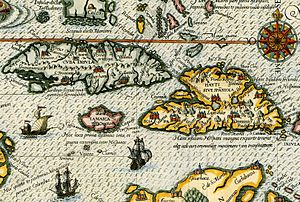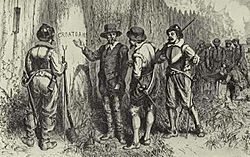Watts' West Indies and Virginia expedition facts for kids
Quick facts for kids Watts' West Indies and Virginia expedition |
|||||||
|---|---|---|---|---|---|---|---|
| Part of the Anglo–Spanish War | |||||||
 Map of the Caribbean in 1594 by Theodor de Bry - the expedition took place in Cuba, Jamaica, & Hispaniola |
|||||||
|
|||||||
| Belligerents | |||||||
| Commanders and leaders | |||||||
| Rodrigo de Rada Vicente González |
Christopher Newport Abraham Cocke |
||||||
| Strength | |||||||
| 17 ships | 6 ships 400 men |
||||||
| Casualties and losses | |||||||
| 1 galleon captured 1 galleon sunk, 4 ships captured, 3 ships run aground |
60 casualties | ||||||
The Watts' West Indies and Virginia expedition was an exciting journey by English ships during the Anglo-Spanish War. It was also called the Action of Cape Tiburon. This adventure took place from May to July 1590. It was led by Captains Christopher Newport and Abraham Cocke. A rich London merchant named John Watts paid for the trip.
The English ships sailed to the Spanish Main, which was the Spanish-controlled parts of the Americas. They stopped and scattered Spanish groups of ships. They captured, sank, or ran many ships aground near the Spanish islands of Hispaniola, Cuba, and Jamaica. Captain Newport was very brave and even lost an arm during a battle, but the English still won. They brought back a lot of valuable goods. A part of this expedition also went to the Roanoke Colony. They found it completely empty, which is why it's known as The Lost Colony.
Contents
Why the Expedition Happened
By the end of 1589, England felt safer from a Spanish invasion. So, English groups, often private companies, started planning trips to raid the Spanish Main. In the spring of 1590, merchant John Watts organized and paid for one such trip in London.
Watts put together a fleet of ships. It included armed merchant ships and some naval vessels borrowed from the English queen. The main ships were the Hopewell (also called Harry and John), led by Captain Abraham Cocke, and the Little John, led by Christopher Newport. There was also a smaller ship called the John Evangelist.
Their main goal was to raid the Spanish West Indies and bring back treasures. On their way back, they also planned to help the colonists at Roanoke. John White, an artist and friend of Sir Walter Raleigh, joined them. White had been on earlier trips to Roanoke and really wanted to go back to help the colonists. Sir Walter Raleigh also helped prepare the fleet. Two ships, the Hopewell and the Moonlight, were specifically meant to break off and sail to Roanoke.
The Journey Begins
On March 20, the English ships left Plymouth, England. They sailed across the Atlantic Ocean without any problems. By May 10, they reached the island of Dominica. They stopped there to get more supplies and food. Two days later, the Hopewell and John Evangelist sailed northwest towards Puerto Rico. The Little John stayed near Dominica for a short time to try and catch any Spanish ships passing by. All three ships later met up again at Saona Island.
Battles Near Santo Domingo
On May 29, off the southern coast of Hispaniola, Abraham Cocke's three ships met up with two more English ships. These were the Moonlight and the Conclude. Cocke's group of five ships then blocked the southern coast of Santo Domingo for two weeks. They captured a Spanish merchant ship called Trinidad and two smaller ships in June. After these captures, the English ships left the blockade. They moved further west towards the Tiburon peninsula of Hispaniola.
Fighting Near Tiburon and Jamaica
On July 12, near Tiburon, fourteen Spanish ships appeared from the east. These ships had left Santo Domingo five days earlier. They were heading to Havana to meet the main Spanish treasure fleet. Captain Vicente González's galleon was protecting them. The English ships got ready to chase them. Newport's Little John and John Evangelist arrived just in time to join the others.
Cocke immediately gave the signal to attack. When the Spanish saw the English ships coming, they decided to scatter. Their armed ships tried to form a defense to let the smaller, less armed ships escape. But when González saw Newport's ships coming from behind Cocke's, he decided to retreat. Most of the Spanish ships scattered southwest. The six English privateer ships chased them until nightfall. They managed to capture one small Spanish ship.
The next morning, the Hopewell, Moonlight, and Conclude found a large Spanish galleon called Buen Jesús anchored nearby. It weighed 350 tons and had nine guns. Cocke attacked by surprise. The Buen Jesús was trying to pull up its anchor and couldn't get away. A long-distance gunfight started. Six Spanish sailors were killed and four were hurt. The English ships then moved closer, firing as they came alongside. They tried to board the Spanish ship but were pushed back. The English didn't give up. They made a stronger attack and finally took control of the ship after a tough, four-hour fight. Most of this fight was hand-to-hand. The English captured 68 Spanish sailors. About 20 Spanish sailors were killed or wounded. The English lost around 15 men.
While the fight for Buen Jesus was happening, the Little John and John Evangelist chased González's main group of ships. These Spanish ships were heading southwest towards the Colony of Santiago (which is now Jamaica). The English and Spanish ships exchanged fire as they chased. When the Spanish ships arrived near Caguaya Bay, the English ships immediately attacked two of them. With intense firing, the English forced these two ships to run aground. The other six or seven Spanish ships that survived reached Santiago de la Vega. English boat parties quickly attacked the grounded ships. The Spanish sailors who tried to defend them were easily driven away. The English then tried to pull both beached ships back into the water using ropes and a helpful southerly wind. They managed to get one ship off the beach, but the other ship was too badly damaged and sank. The English then got back on their ships. With their new captured ship, they sailed northwest towards Cape Corrientes.
On July 14, Cocke gave the captured Buen Jesus to Newport to protect it. Its cargo was huge and needed to be taken back to England quickly. The cannons and guns were taken off the ship. Newport's victorious ships then left the Jamaican coast and headed east towards Cuba.
Battle Near Cayo Jutias
At sunset on July 18, Newport's Little John and John Evangelist saw three Spanish merchant ships near Cayo Jutias. This is west of Havana in Cuba. These ships were stragglers from a group led by Commodore Rodrigo de Rada. That group had entered Havana five days earlier. The English attacked in the dark and opened fire, forcing one ship to turn back.
The next morning, the English got closer to the remaining two ships. These were the Nuestra Señora del Rosario and a smaller ship called Nuestra Señora de la Victoria. The Spanish had tied both ships together. A long-distance artillery battle began, which the English won. They badly damaged the Victoria. The English then moved close to the Victoria and managed to board it. A fierce hand-to-hand fight followed. Newport killed the Spanish captain in the fight. But soon after, another Spanish sailor cut off Newport's right arm while trying to protect his captain. However, Newport was saved by an English soldier who killed the attacker. The Spanish were soon forced off the ship. The English lost five men and had sixteen wounded, including Newport. The Spanish had even more losses.
The English then found that the Victoria was so badly damaged that it sank within fifteen minutes. It took much of its silver cargo with it. The next target, the Spanish ship Rosario, was quickly boarded. Another tough fight took place, but again the English soon forced the Spanish off the ship. The English had two killed and eight injured. The Rosario was also badly damaged and sinking. The English had no choice but to run the ship ashore at the western end of Cayo Jutias. Soon after, Newport, even though he was in pain and shock, still gave orders. He released the Spanish prisoners and sent them ashore. The English then took what they could from the ship. They only found a small amount of valuables. After that, the ship was broken up and burned. Newport, with only half his arm, ordered the ships to return to England.
Newport sailed back to England, leaving Cocke in charge. So, the Hopewell and the Moonlight, with John White, sailed to Roanoke to complete their part of the mission.
The Search for Roanoke Colony
Meanwhile, the other part of the expedition tried to land at the English colony of Roanoke. John White's landing at the Outer Banks was made even harder by bad weather. The landing was dangerous due to strong currents and poor conditions.
On August 18, 1590, White finally reached Roanoke Island. But he found that his colony had been empty for a long time. The only clues about where the colonists went were the letters "CRO" carved into a tree. The word "CROATOAN" was carved on a post of the fort. Croatoan was the name of a nearby island (now called Hatteras Island) and a local Native American tribe. The colonists had agreed that if they moved, they would carve a message into a tree. They would also carve a Maltese Cross if they were forced to leave. There was no sign of the colonists, and the weather got worse. So, White returned to Plymouth on October 24, 1590.
What Happened Next
Newport returned home by early September and was welcomed as a hero. The expedition had been very profitable. The biggest and most valuable prize was the 300-ton Buen Jesus. It sailed into Plymouth in September. This ship was from Seville, Spain, and carried goods typical of Spanish trade at the time. On board were 200 boxes of sugar, at least 5,000 animal hides, 2,000 hundredweight of ginger, 400 hundredweight of guacayan wood, twelve hogsheads of Chile pepper, twenty hundredweight of sarsaparilla, twenty hundredweight of cane, and over 4,000 ducats in pearls, gold, and silver.
The English expedition and the defeat of the Spanish ships made the Spanish very frustrated. Their commander, Rodrigo de Rada, wrote later:
the shamelessness of these English ships has reached a point they have come very close to this harbour [Havana] even pursuing barges which bring water from a league away.
Newport loved finding valuable prizes. Even though he lost his arm, he set out again. He owed his life to the ship's surgeon. The next year, as captain of the Margaret, he combined trade with North Africa and more successful trips paid for by Watts. One of these was the Blockade of Western Cuba. Between 1592 and 1595, when he was captain of the Golden Dragon, Newport stayed in the West Indies. In 1592, he led a group of privateer ships and started attacking Spanish towns in the Caribbean. When he returned, he helped to capture the Madre de Deus near the Azores. He was chosen to sail her to England, which made him a very rich man.
Newport's Legacy
In the movie New World about the Jamestown Settlement, Christopher Newport was played by Christopher Plummer. In the movie, he was wrongly shown with both arms. There is a statue of him at Christopher Newport University, which is named after him.



